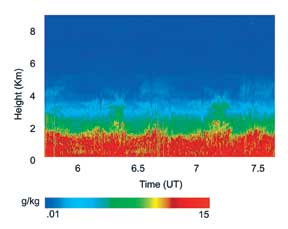Raman Lidar instrument
Raman Lidar Goes Airborne to Demonstrate New Measurement Capability, Support WAVES Campaign.
January, 2008
![]()
 This water vapor mixing ratio time series was one of several data sets acquired during the first flights of the RASL instrument in summer 2007. RASL, which can take profile measurements of water vapor and various aerosol and cloud properties, is proving to be an important asset, particularly since recent satellite data has shown increases in atmospheric moisture content that may be linked to climate change.
This water vapor mixing ratio time series was one of several data sets acquired during the first flights of the RASL instrument in summer 2007. RASL, which can take profile measurements of water vapor and various aerosol and cloud properties, is proving to be an important asset, particularly since recent satellite data has shown increases in atmospheric moisture content that may be linked to climate change.
In June through August of 2007, the Raman Airborne Spectroscopic Lidar (RASL) instrument flew numerous times on board a KingAir aircraft out of Bridgewater, VA, in support of the 2007 Water Vapor Validation Experiments (WAVES) campaign. The WAVES campaign is a series of field experiments to validate satellite measurements. RASL data, along with data from ground-based and balloon-borne instruments, are being used to assess the CALIPSO and TES instruments and for studies of mesoscale water vapor variability. During the test flights, RASL produced the first-ever simultaneous measurements of tropospheric water vapor mixing ratio and aerosol extinction from an airborne platform.
Atmospheric water vapor plays important roles in atmospheric stability, cloud formation and convective storm development. Because Water vapor is the strongest greenhouse gas, a better understanding of water vapor and its interactions with aerosols is key to forecasting how the Earth’s water cycle will respond to increased atmospheric temperature caused by climate change. The 2007 test flights demonstrated RASL’s unique ability to quantify aerosol properties simultaneously with the water vapor environment, which makes RASL a powerful remote sensing tool for future aerosol, water vapor and cloud studies.
While Lidar is a proven method for water vapor measurements, the RASL project team, based at NASA’s Goddard Space Flight Center, sought to broaden the range of capabilities to include daytime and nighttime measurements of water vapor, aerosol backscatter, extinction, and depolarization as well as nighttime measurements of cloud liquid water and carbon dioxide. These kinds of detailed measurements hold promise for improved understanding of the processes underlying the cycling of water and are crucial for improving our ability to model weather and climate globally.
Future plans for the technology include the addition of injection seeding, which would both narrow the output spectrum and make it easier to align the output wavelength of the laser with the peak transmissions of the interference filters. This upgrade would also enable temperature profiling in order to quantify relative humidity directly using RASL data without the need for radiosondes or other data sources for temperature.
At present, RASL remains a valuable research tool for quantifying water vapor and aerosols in the atmosphere and is available for NASA missions flying on board the B200 KingAir aircraft. The RASL project completed its final year of ESTO funding under the Instrument Incubator Program in October.